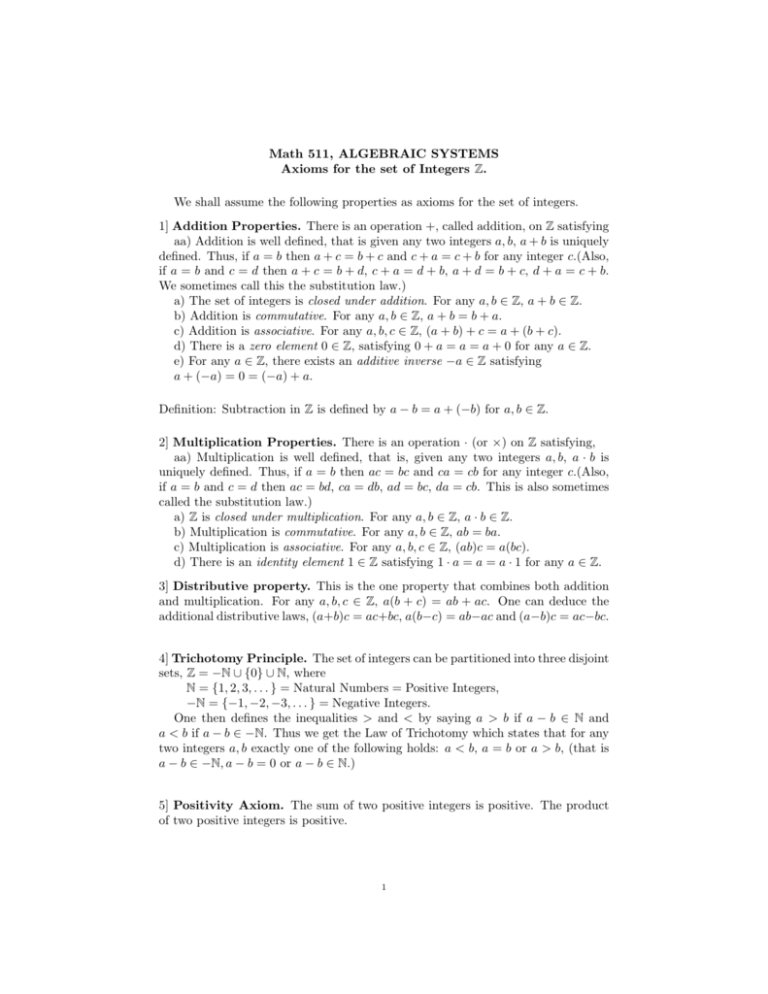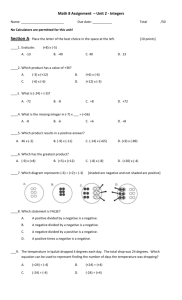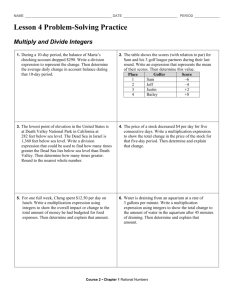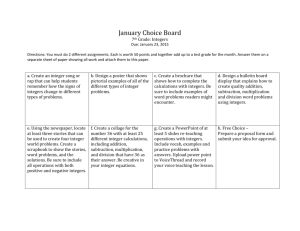Axioms and Further Properties for the Integers
advertisement

Math 511, ALGEBRAIC SYSTEMS
Axioms for the set of Integers Z.
We shall assume the following properties as axioms for the set of integers.
1] Addition Properties. There is an operation +, called addition, on Z satisfying
aa) Addition is well defined, that is given any two integers a, b, a + b is uniquely
defined. Thus, if a = b then a + c = b + c and c + a = c + b for any integer c.(Also,
if a = b and c = d then a + c = b + d, c + a = d + b, a + d = b + c, d + a = c + b.
We sometimes call this the substitution law.)
a) The set of integers is closed under addition. For any a, b ∈ Z, a + b ∈ Z.
b) Addition is commutative. For any a, b ∈ Z, a + b = b + a.
c) Addition is associative. For any a, b, c ∈ Z, (a + b) + c = a + (b + c).
d) There is a zero element 0 ∈ Z, satisfying 0 + a = a = a + 0 for any a ∈ Z.
e) For any a ∈ Z, there exists an additive inverse −a ∈ Z satisfying
a + (−a) = 0 = (−a) + a.
Definition: Subtraction in Z is defined by a − b = a + (−b) for a, b ∈ Z.
2] Multiplication Properties. There is an operation · (or ×) on Z satisfying,
aa) Multiplication is well defined, that is, given any two integers a, b, a · b is
uniquely defined. Thus, if a = b then ac = bc and ca = cb for any integer c.(Also,
if a = b and c = d then ac = bd, ca = db, ad = bc, da = cb. This is also sometimes
called the substitution law.)
a) Z is closed under multiplication. For any a, b ∈ Z, a · b ∈ Z.
b) Multiplication is commutative. For any a, b ∈ Z, ab = ba.
c) Multiplication is associative. For any a, b, c ∈ Z, (ab)c = a(bc).
d) There is an identity element 1 ∈ Z satisfying 1 · a = a = a · 1 for any a ∈ Z.
3] Distributive property. This is the one property that combines both addition
and multiplication. For any a, b, c ∈ Z, a(b + c) = ab + ac. One can deduce the
additional distributive laws, (a+b)c = ac+bc, a(b−c) = ab−ac and (a−b)c = ac−bc.
4] Trichotomy Principle. The set of integers can be partitioned into three disjoint
sets, Z = −N ∪ {0} ∪ N, where
N = {1, 2, 3, . . . } = Natural Numbers = Positive Integers,
−N = {−1, −2, −3, . . . } = Negative Integers.
One then defines the inequalities > and < by saying a > b if a − b ∈ N and
a < b if a − b ∈ −N. Thus we get the Law of Trichotomy which states that for any
two integers a, b exactly one of the following holds: a < b, a = b or a > b, (that is
a − b ∈ −N, a − b = 0 or a − b ∈ N.)
5] Positivity Axiom. The sum of two positive integers is positive. The product
of two positive integers is positive.
1
2
6] Discreteness Properties.
a) Well Ordering Property of N. Any nonempty subset of N has a smallest
element.
b) Principle of Induction. Let S be a subset of N such that
(i) 1 ∈ S and
(ii) n ∈ S ⇒ n + 1 ∈ S.
Then S = N.
Further Properties of Z. The properties below can all be deduced from the
axioms above. You may assume them in your homework unless specifically asked
to prove the property.
7] Cancellation law for addition: If a + x = a + y then x = y.
Cancellation law for multiplication: If ax = ay and a 6= 0 then x = y.
8] Additive inverses are unique, that is, if a, b, c are integers such that a + b = 0
and a + c = 0 then b = c.
9] Zero multiplication property: a · 0 = 0 for any a ∈ Z.
10] Zero divisor property, or integral domain property: If ab = 0 then a = 0 or
b = 0.
11] Properties of negatives: (−a)b = −(ab) = a(−b), (−a)(−b) = ab.
12] The product of two negative integers is positive.
13] “FOIL” Law (and all similar distributive laws): For any integers a, b, c, d,
(a + b)(c + d) = ac + ad + bc + bd.
14] Genassocomm Law: General Associative-Commutative Law:
a) Addition: When adding a collection of n integers a1 + a2 + · · · + an , the
numbers may be grouped in any way and added in any order. In particular, the
sum a1 +a2 +· · ·+an is well defined, that is, no parentheses are necessary to specify
the order of operations.
b) Multiplication: When multiplying a collection of n integers a1 a2 · · · · · an , the
numbers may be grouped in any way and multiplied in any order. In particular,
the product a1 a2 · · · · · an is well defined, that is, no parentheses are necessary to
specify the order of operations.
15] Binomial Expansion:
For anyintegers a, b and positive integer n we have
(a + b)n = an + n1 an−1 b + n2 an−2 b2 + · · · + bn .
In particular,
(a + b)2 = a2 + 2ab + b2
(a + b)3 = a3 + 3a2 b + 3ab2 + b3 .







